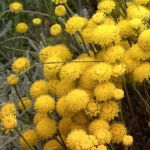| Common Name: |
Cotton Lavender |
| Other Names: |
Lavender Cotton |
| Botanical Name: |
Santolina chamaecyparissus |
| Genus: |
Santolina |
| Family: |
Asteraceae |
| Native Location: |
W and C Mediterranean |
| Cultivation: |
Light, well-drained to dry soil in sun. Tolerates sady and poor, alkaline soils. Cut back hard in spring. Remove dead flower heads and trim in autumn. |
| Propagation: |
By seed sown in autumn or spring; by semi-ripe cuttings in late summer. |
| Harvest: |
Leaves are picked in the growing season, flowering stems in summer; both are dried for use in infusions and powders. |
| Height: |
20-50cm (8-20in) |
| Width: |
60-90cm (24-36in) |
| Hardiness: |
Z6-8 |
| Variations: |
Lambrook Silver
Has silver-gray leaves. |
Lemon Queen
Is compact, with cream flowers and gray-green leaves that have a slightly sweeter aroma than the species.
Height: 60cm (24in)
Width: 60cm (24in) |
Var. nana
Is the smalles santolina. Ideal for alpine troughs.
Height: 15cm (6in)
Width: 15cm (6in) |
Pretty Carol
Is compact, with silver foliae, and bright yellow flowers.
Height: 25-50cm (10-20in)
Width: 60cm (24in) |
Small-Ness
Is dwarf. Suitable for containers or a miniature hedge.
Height: 20cm (8in) |
|
| Parts Used: |
Leaves, flowering stems |
| Properties: |
A bitter, stimulant herb with a strong, chamomile-like aroma. It reduces inflammation, improves digestion, stimulates the uterus and liver, and expels intestinal parasites. |
| Medicinal Uses: |
Internally for poor digestion, digestive and menstrual problems, worms in children, and jaundice. Externally for stings, bites, minor wounds, and skin inflammations. |
| Culinary Uses: |
Leaves are used to flavor meat and fish dishes, grains, soups, and sauces. |
| Aromatic Uses: |
Dried leaves are added to potpourris. |
| Economic Uses: |
Dried leaves are blended with Chamaemelum nobile (See, Roman Chamomile) and Tussilago farfara (See, Coltsfoot) in herbal tobacco. |
| Bibliography: |
The Encyclopedia of Herbs by Deni Bown Copyright © 1995, 2001 Dorling Kindersley Limited pp.359-360 |

